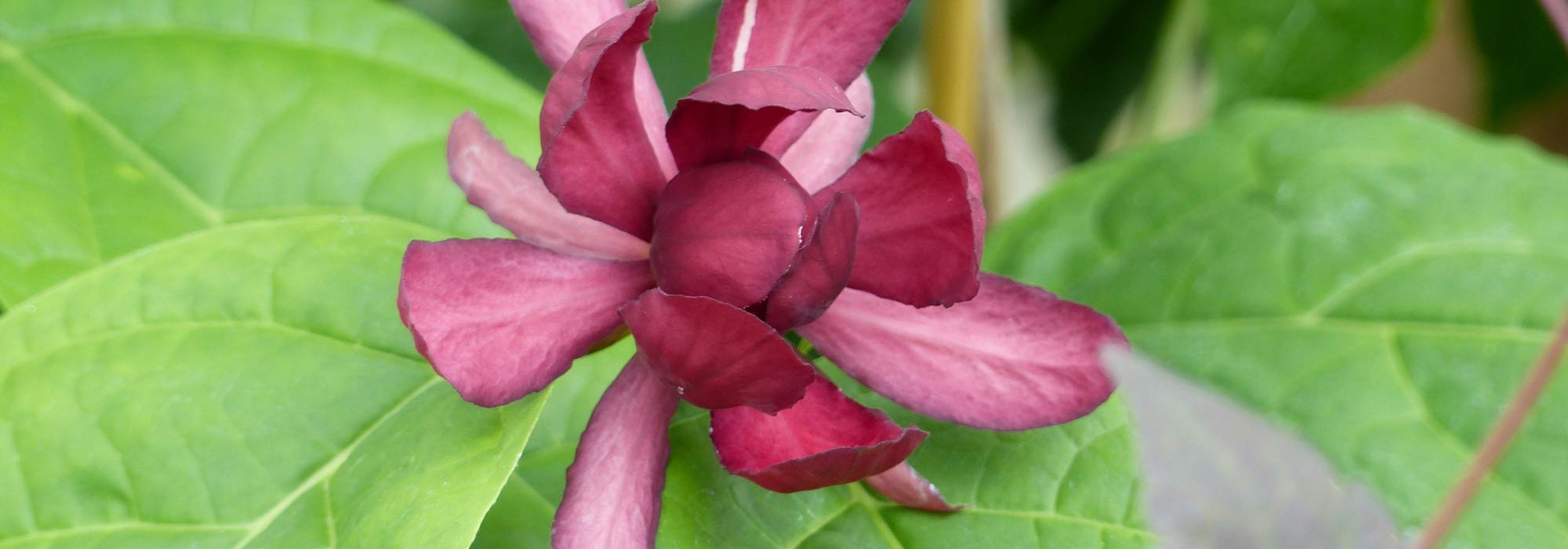
Calycanthus or sweetshrub: planting, pruning and care
Contents
Calycanthus in a nutshell
- The anemone tree is a beautiful bush with elegant flowers in late spring
- Original, its flowers exude a subtle strawberry fragrance
- It is very hardy (-20°C) and never gets sick
- Of fairly compact size, it reaches 2 m in height in 5-6 years
- It is easy to grow and only requires sunlight to thrive
A word from our expert
Still relatively unknown, the Calycanthus or Anemone Tree, also known as the “Pompadour Tree”, is a shrub with a long and original spring and summer flowering that deserves a prominent place in every garden. It flowers from a young age!
From late spring through summer, its flowers, resembling small water lilies or magnolias, open to release a subtle strawberry fragrance, while its leaves emit a camphor-like scent when crushed.
Alongside Calycanthus floridus, the Calycanthus occidentalis coexists with its long brown-purple flowering. While most have a red-purple flowering (Calycanthus ‘Aphrodite’, Calycanthus ‘Hartlage Wine’), the white Calycanthus ‘Venus’ produces large white flowers.
Accommodating and very easy to grow, the Calycanthus prefers a deep, rich, cool and well-drained soil, but adapts to all types of soil.
It enjoys a sunny position sheltered from cold winds to flower well.
This never-sick shrub has a rapid growth rate and will reach its adult size in less than 6 years.
Its bushy and graceful silhouette and moderate size allow for various uses in all gardens, even small ones, from the most naturalistic to the most sophisticated.
Whether planted as a specimen, in a flowering hedge, in a border, or even in a pot on the terrace, this very hardy shrub down to -20°C will reveal its originality throughout the beautiful season.
Robust, very tolerant, and low-maintenance, the Calycanthus truly has everything to please. Discover this shrub that will bring a touch of originality to your garden without delay!
Description and Botany
Botanical data
- Latin name Calycanthus
- Family Calycanthaceae
- Common name Anemone Tree, sweetshrub, spice bush
- Flowering From June to September
- Height 1.5 to 2 m
- Sun exposure Sun, partial shade
- Soil type All, well-drained
- Hardiness -20°C
The Calycanthus or Anemone Tree, sometimes also called “Pompadour Tree”, is a deciduous bush from the Calycanthaceae family, native to the forests and riverbanks of the southern United States, particularly Florida. The genus includes less than 5 species, including calycanthus floridus and its hybrids such as Calycanthus floridus var. Glaucus ‘Purpureus’ and Calycanthus occidentalis, known for its long flowering period.
There is also Calycanthus chinensis or Sinocalycanthus chinensis, a Chinese species closely related to Calycanthus. Only in recent years has Calycanthus (x) raulstonii emerged, a new hybrid variety resulting from the cross-breeding of Calycanthus floridus and Sinocalycanthus chinensis. It has given rise to several interesting cultivars, notably ‘Aphrodite’ and ‘Hartlage Wine’, as well as Calycanthus ‘Venus’, with its white flowers.
With a rapid growth and a bushy habit that is rather rounded with stiff branches, the calycanthus can reach its adult size of up to 2 m in height and nearly the same in spread in just 5 to 6 years.
Its aromatic bark releases a spicy cinnamon scent when dried.
This bush is valued for its very long flowering, which is both abundant and original. From late spring, from June to July, and sometimes until autumn, large solitary flowers resembling anemones, small water lilies, or magnolias appear as if “placed” at the ends of the branches.
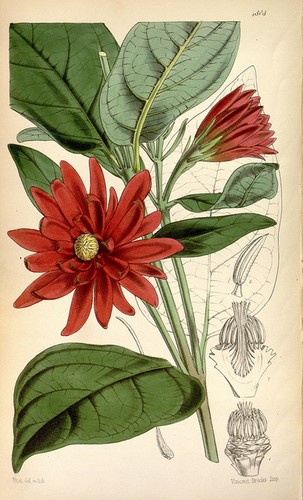
Calycanthus occidentalis – botanical illustration.
Carried by a short peduncle, these large delicate flowers open in wide cups measuring 4 to 7 cm in diameter. They are composed of numerous narrow petals and sepals, lanceolate to elliptical, surrounding a small central crown of tiny petals that encase a bouquet of stamens. The corolla never fully opens.
Traditionally a magnificent red-purple, claret, or reddish-brown, sometimes edged with white on the petals, Calycanthus ‘Venus’ features large pure white flowers with a remarkable purple centre.
Delightfully fragrant, all release a surprising fruity scent that some describe as a mix of wild strawberry, green apple, or wine.
They give way to fruits, resembling small elongated nuts or green figs that turn brown, containing a few large oblong black seeds.
The Calycanthus displays a lush bright green deciduous foliage on top, with a fuzzy grey underside. These large opposite leaves, oval to elliptical, 5 to 20 cm long, sometimes turn golden yellow and rusty in autumn, depending on the variety.
When crushed, the leaves of calycanthus floridus emit a slight camphor scent.
Easy to cultivate, the Anemone Tree grows in full sun or light shade, in any non-calcareous, rich, deep, well-moistened and well-drained soil.
Although it tolerates -15°C, it should be grown sheltered from cold winds.
It can be used, depending on your desires, as a solitary specimen, in a free and rustic hedge, or in a large bed mixing perennials and small bushes. Plant it near a path or close to the terrace, to enjoy the original beauty of its flowers.

Calycanthus raulstonii ‘Hartlage Wine’: flower and golden autumn foliage.
Main species and varieties
The range of Calycanthus has recently expanded in France, although it is still limited to a few species all very floriferous and fragrant. Hybrid Calycanthus such as Calycanthus raulstonii ‘Aphrodite’ complement a selection primarily guided by the sumptuous colours of the flowers ranging from purplish-red or reddish-brown to the pure white of Calycanthus ‘Venus’.
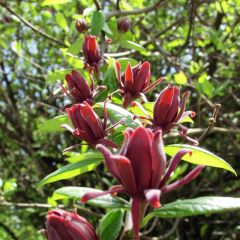
Calycanthus floridus - Sweetshrub
- Flowering time June, July
- Height at maturity 2 m
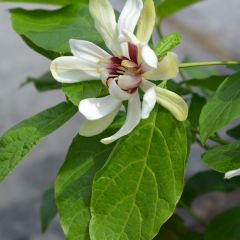
Calycanthus Venus- Sweetshrub
- Flowering time June to October
- Height at maturity 2 m
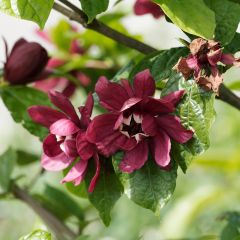
Calycanthus raulstonii Aphrodite- Sweetshrub
- Flowering time June to October
- Height at maturity 1,70 m
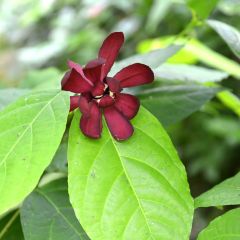
Calycanthus raulstonii Hartlage Wine- Sweetshrub
- Flowering time June to October
- Height at maturity 2 m
Discover other Calycanthus
View all →Available in 0 sizes
Available in 2 sizes
Available in 1 sizes
Available in 2 sizes
Available in 2 sizes
Available in 1 sizes
Available in 1 sizes
Available in 1 sizes
Available in 1 sizes
Planting
Where to plant Calycanthus?
With good hardiness, it can withstand very low temperatures of around -20 °C, ensuring perfect resilience in all regions.
Calycanthus needs warmth and light to flower. It is best to protect it from cold winds that could dry out its young shoots in spring and damage its flower buds: provide it with a sunny, preferably non-scorching and well-sheltered location. In warm regions, it can tolerate being planted in light shade.
Not very demanding, Calycanthus adapts to almost any type of soil as long as it is deep, not too dry, and fairly rich. Even acidic soil like heather soil will suit it. It will thrive better in soil that is not too calcareous, remaining cool in summer but well-drained: it dislikes heavy, waterlogged soils in winter.
Think carefully about its location, as it does not like being transplanted once well-rooted!
As an adult, Calycanthus will not exceed 2 m in height and can be used in a free hedge, in a flowering shrub or perennial bed, as a solitary plant near the house, or even in a pot on the terrace.
When to plant the Anemone Tree?
Calycanthus is planted in early spring after the last severe frosts or in autumn, from September to November, to allow for good root development.
How to plant Anemone Trees?
- In the ground
The soil must be well worked in depth to accommodate the Calycanthus, which appreciates well-drained soils where water does not stagnate, especially in winter. Space the plants about 1.20 m apart. In overly heavy soil, lighten it with potting soil.
- Dig a hole at least 3 times wider than the volume of the root ball
- Loosen the soil well
- Ensure good drainage with river sand or gravel at the bottom of the hole
- Enrich half of the extracted soil with compost
- Plant the bush, leaving the root ball level with the soil (if necessary, make a small mound of soil to support the roots)
- Backfill the hole while keeping the bush upright and lightly compact
- Create a small basin to retain water
- Spread an organic mulch to keep the base clean and cool during summer
- Water generously with 2 watering cans at planting
- In a pot
Calycanthus (x) raulstonii is well-suited for pot cultivation. The substrate must be rich enough and well-draining to avoid stagnant moisture at the roots. Repot every 2 or 3 years.
- At the bottom of a container at least 50 cm in diameter, spread a good layer of drainage (gravel or clay balls)
- Plant in good potting soil for shrubs enriched with compost
- Mulch the base
- In summer, water well during flowering and as soon as the soil is dry
→ Learn more about the cultivation of Calycanthus in pots in our advice sheet!
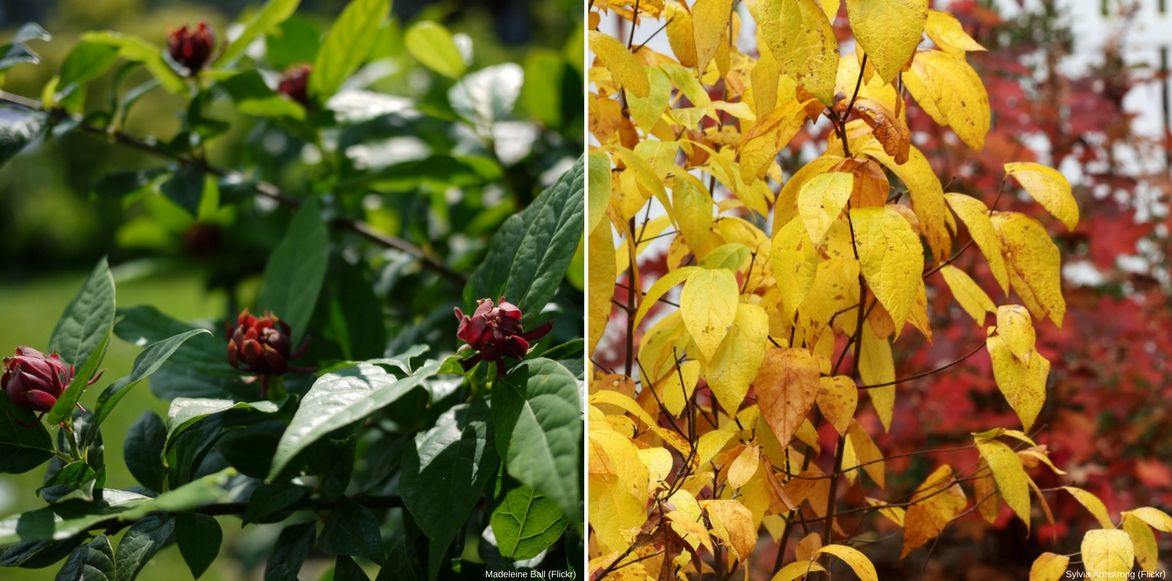
Calycanthus floridus in June / Autumn foliage against a backdrop of Hydrangea quercifolia.
Pruning and care
Calycanthus requires little maintenance: a good organic mulch, some organic fertiliser, and light pruning.
While the Anemone Tree easily adapts to all types of soils, it prefers cool, not too dry soils. In the first year, regular watering is essential. In summer, water once or twice a week during hot weather. To keep the base cool during the warm season, apply a good organic mulch before spring, especially in the first few years after planting.
Calycanthus is a greedy plant that will appreciate annual compost additions each spring.
Pruning is not essential, except to rebalance the habit that develops with age, encourage the formation of young stems, and rejuvenate the bush.
- At the end of winter, in March-April, prune only every two or three years, ensuring good aeration in the centre of the branches
- Cut back to ¼ of the length of dead, thin, or tangled branches
Diseases and potential pests
Hardy and resilient, there are no particular diseases or pests known for Calycanthus.
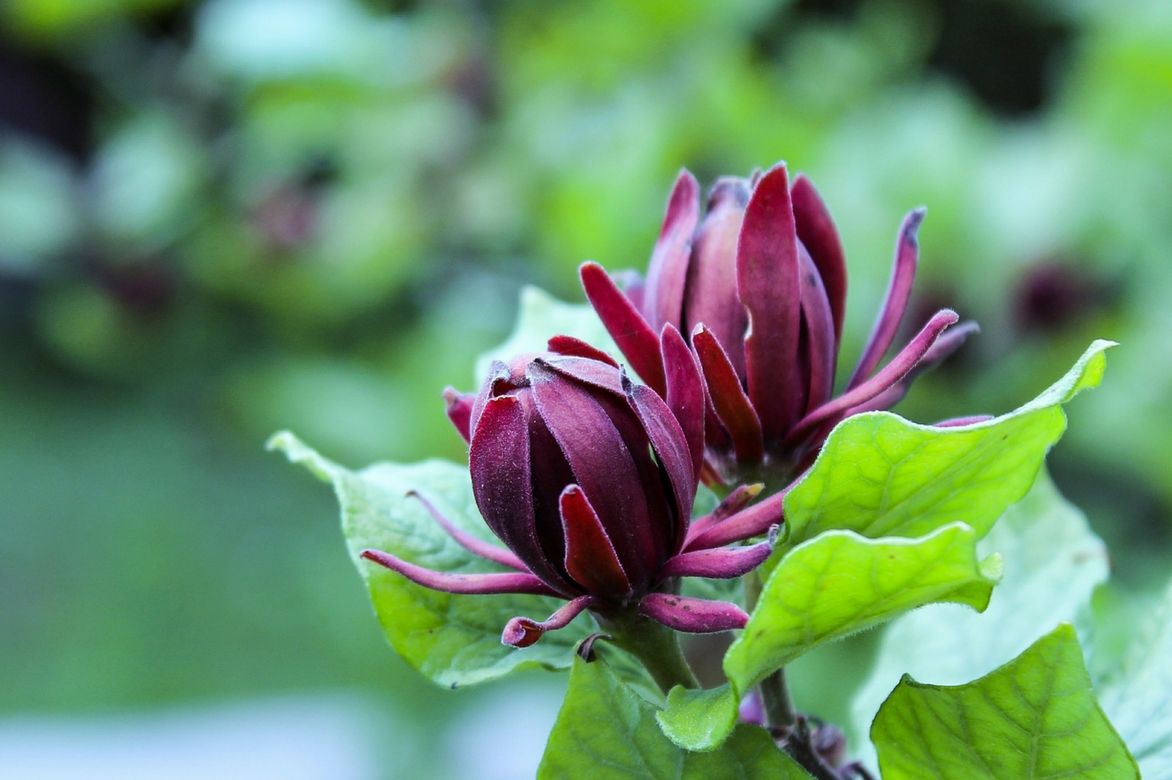
The stunning flowering of Calycanthus floridus.
Multiplication
The simplest multiplication method for the Anemone Tree remains layering, to be carried out at the end of winter.
By layering
While propagation by cuttings is possible, layering in spring remains, in our opinion, the easiest method.
- Dig a furrow in the soil near the parent plant
- Choose a low stem that is easy to bend to the ground
- Burrow 1 or 2 nodes of lignified wood about twenty centimetres deep
- Raise the leafy end of the shoot and stake this aerial part
- Fill in the furrow and secure the layer with a hook or a stone
- The buds root within 1 year: separate the layer from the parent plant when it has enough roots the following spring
- Cut the stem at the point where it goes into the soil to wean the layer
- Transplant immediately into open ground and water
Associating
A touch of sophistication, the Calycanthus is the star of every garden, bringing with its profusion of delicate flowers in spring and summer, originality, colour, and contrast. Whether in striking punctuation or mixed, it easily integrates into any decor. It is a must-have for purple gardens.
Stunning when planted solitary in a strategic spot in the garden, it can also be used in a free-flowing, rustic hedge, or in a large bed of perennials and small bushes.
With its large anemone-like flowers in a lovely purple-magenta, it fits beautifully into natural gardens, alongside a Dicentra formosa ‘Bacchanal’, perennial cinquefoils (‘Hopwoodiana’ or ‘Gibson S Scarlet’), an Papaver Orientale ‘Patty’s Plum’ or Heucheras ‘Georgia Plum’ and ‘Forever Purple’, a Salvia nemorosa ‘Amethyst’, or even a Lupin ‘West Country Masterpiece’ to create a lush marriage.
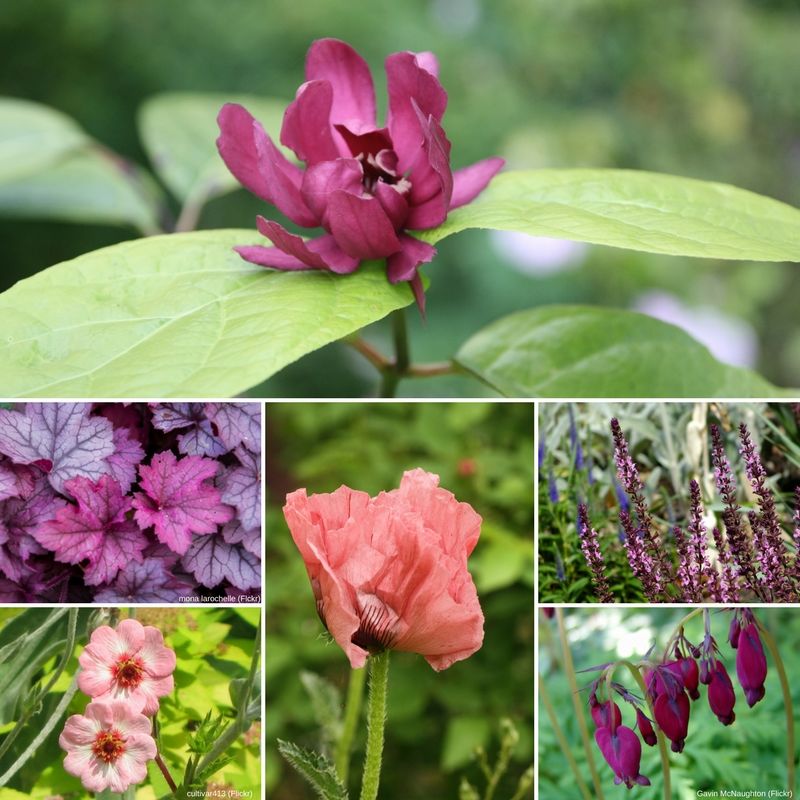
An example of association in a lovely blend of pink and purple: Calycanthus raulstonii ‘Hartlage Wine’ / Heuchera ‘Georgia Plum’ / Potentilla ‘Hopwoodiana’ / Papaver ‘Patty’s Plum’ / Salvia nemorosa ‘Amethyst’ / Dicentra formosa ‘Bacchanal’.
With its bushy silhouette and preference for a certain acidity, it will make a statement alongside heather soil shrubs such as Andromedas, Magnolias, or shrub peonies.
At the back of a bed, or in a flowering hedge, it will be accompanied by white or pink bush roses, a Leycesteria Formosa ‘Purple Rain’, Pheasant Tree, an Buddleja colvilei, a Cornus, or a Physocarpus.
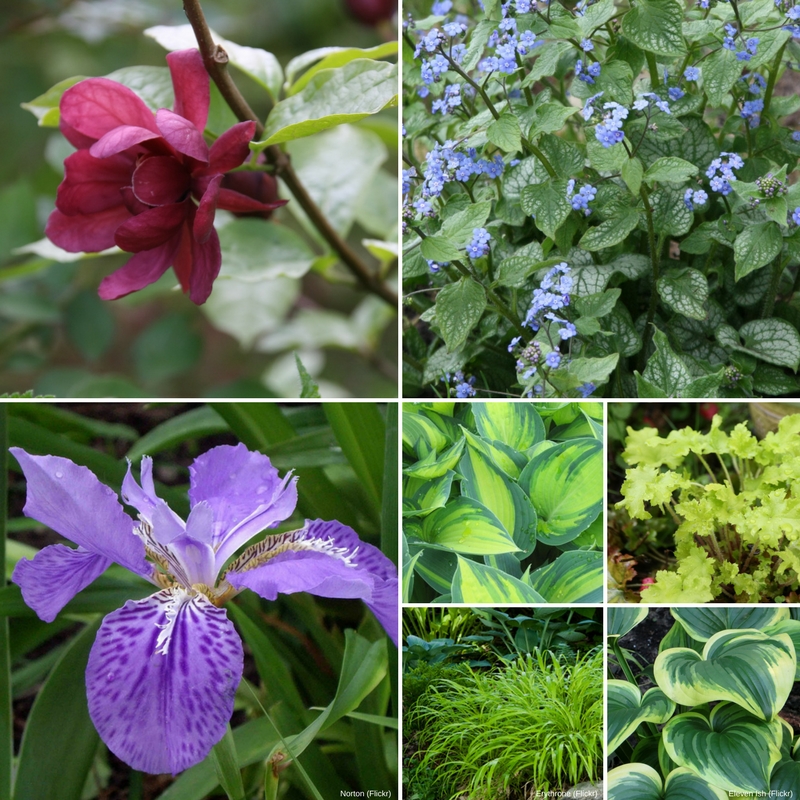
An example of a more contrasting association in a light woodland atmosphere: Calycanthus raulstonii ‘Hartlage Wine’ / Brunnera macrophylla ‘Jack Frost’ / Iris tectorum / Hosta ‘June’ / Heuchera ‘Citronelle’ / Hakonechloa macra ‘AllGold’ / Hosta ‘Fragrant Dream’.
Useful resources
- Exclusive Calycanthus varieties are with us!
- Subscribe!
- Contents
































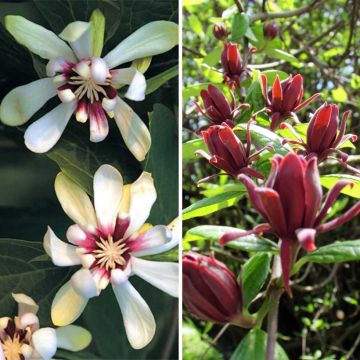




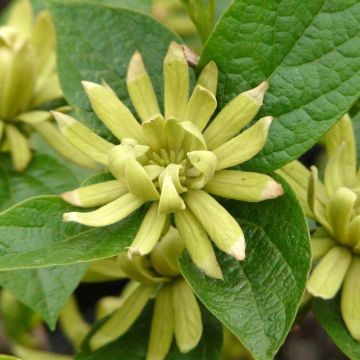
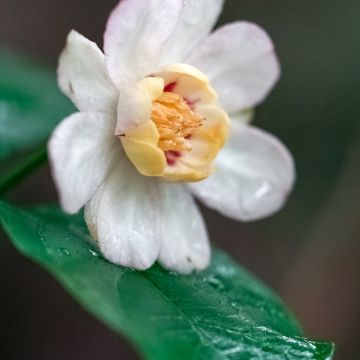
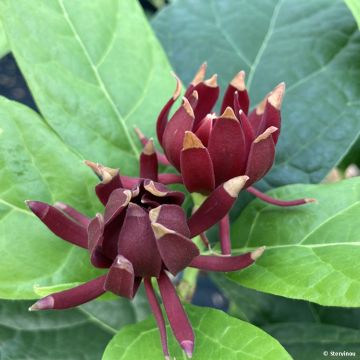
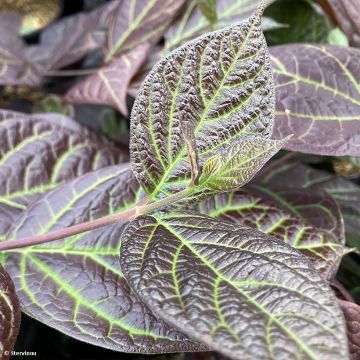
Comments